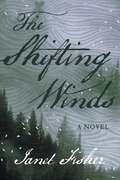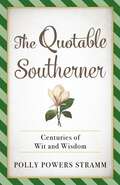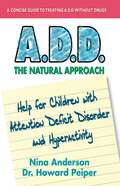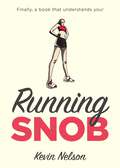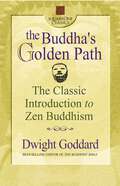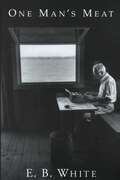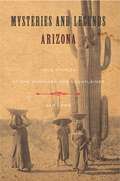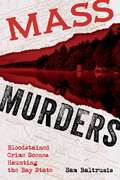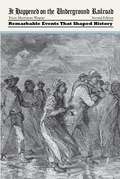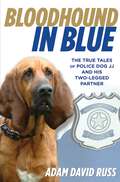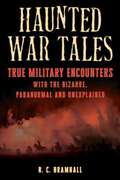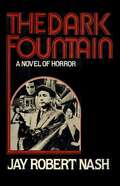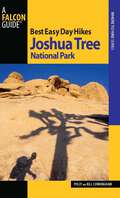- Table View
- List View
Diary of an Exercise Addict
by Peach FriedmanIn 2000, Peach Friedman, a college senior freshly broken up from her boyfriend, set out to beat the blues by beating herself into shape. Running ten miles a day and taking in as little as 800 calories, she fell from 146 pounds to 100 in three months and was at serious risk of cardiac arrest. What Friedman suffered from was exercise bulimia—a newly diagnosed and rapidly spreading eating disorder that affects some 400,000 American women, and which gyms and colleges across America are beginning to take seriously. In Diary of an Exercise Addict Friedman recounts her descent into a life-threatening illness, her remarkable recovery, and the setbacks along the way. With refreshing candor she lays bare her relationships with family, friends, and lovers and the repressed desire that finally surfaced as she found her own way back to health.
Tales of the Yankee Clipper: Stories and Reflections on Joe DiMaggio (Yankees Icon Trilogy)
by Jonathan WeeksThere has probably never been a professional baseball player more of a puzzle than Joe DiMaggio. DiMaggio had a talent for keeping his emotions suppressed and his innermost thoughts to himself. Few could say that they really knew him. And even the ones who did found him to be unpredictable. He was a walking contradiction. He was quiet, but not necessarily shy. He could be both gracious and abrupt, approachable or aloof depending on the situation. Although he came across as humble, he had a tremendous sense of entitlement. He was complex, secretive, inscrutable. There were many layers to the man who came to be affectionately known as the &“Yankee Clipper.&” DiMaggio always felt that his actions on the field should do the talking for him. And for the most part, they did. To many, DiMaggio personified elegance, style, and grace. An impeccable dresser, he was married to two glamorous actresses. On the field, he glided almost effortlessly, never having to dive for a ball and rarely (if ever) making a mistake on the basepaths. He became the living embodiment of the American dream and a symbol of the country&’s so-called &“greatest generation.&” But as time marched on, DiMaggio grew increasingly distrustful of the people around him. It was understandable—inevitable even. The third book in Jonathan Week&’s Yankees trilogy contains an abundance of anecdotes, statistics, and other little known facts about the Yankee Clipper.
How to Start a Home-based Makeup Artist Business (Home-Based Business Series)
by Deanna NickelEverything you need to know to run a profitable and satisfying makeup artist business from your homeThis comprehensive guide takes you through every aspect of setting up and running a thriving home-based makeup artist business, from separating yourself from your competition and successful branding techniques to makeup must-haves and have-nots. Learn all about developing a price structure, traditional versus online marketing, getting press, and establishing policies, and enjoy an entire section on how to tap into the lucrative bridal market. Whether you are just starting out or looking to expand your business, each chapter can help you build your own successful home-based makeup artist business. Look for useful charts and worksheets throughout the book, including: Standard Face ChartSample Client CardMarketing Strategy Worksheet Sample ContractBridal Trial Chart
Green House: Eco-Friendly Disposal and Recycling at Home
by Norm CramptonConsumers may already recycle newspapers and aluminum cans. But what about the containers that have both plastic and cardboard components? Should we really toss water bottle caps? Scratched CDs? Computers? Cell Phones? Green House: Eco-Friendly Disposal and Recycling at Home is an A to Z guide to disposing and recycling all varieties of common household trash, from broken appliances to spent smoke detectors to pet waste. Crampton provides informative, comprehensive and practical information for adopting greener and more earth friendly habits of disposal by promoting recycling and living a little lighter.
Boat Troop: An SAS Thriller
by Johnny "Two HowardWithin two weeks of the Argentine invasion of the Falkland Islands, four men of Boat Troop, B Squadron, 22 SAS, are on the islands too. It is the mission of these four men to gather vital intelligence without being detected by Argentine patrols. The rest of B Squadron are tasked with a suicide mission—an attack on the Argentine airbase in the mainland. In charge is a man unafraid to risk the lives of his men in search of greater personal glory.
The Shifting Winds
by Janet FisherThis is the story of reluctant Oregon pioneer Jennie Haviland, who must give up study at her academy in New York when her father takes the family west over the Oregon Trail. In Oregon Jennie meets two young men, American mountain man Jake Johnston and British Hudson's Bay Company clerk Alan Radford. The two men vie for Jennie, as their nations vie for the contested territory of this rich western frontier. But Jennie wants choices of her own.
The Civil War Quiz Book: 1,600 Questions and Answers to Test Your Knowledge of America's Most Divisive Conflict
by Blake A. MagnerIf you think you know a lot about the Civil War, challenge yourself with this instructive and intriguing book of questions. Covering every battle of the war, commanders and ordinary soldiers, weapons, and armies, this book will test the knowledge of even the most dedicated history buff. Degrees of difficulty range from elementary to questions that even the author had difficulty figuring out, and everything in between. Thousands of provocative questions will sharpen the knowledge of Civil enthusiasts everywhere.
The Quotable Southerner: Centuries of Wit and Wisdom
by Polly Powers StrammSoutherners have always had something to say. Focusing on the unique qualities of both the landscape and people, Quotable Southerner showcases the linguistic insight of the region&’s native and adopted sons and daughters. Sometimes insightful, sometimes hilarious, these quotes will have readers smiling, laughing, and shaking their heads.
A.D.D. The Natural Approach
by Nina Anderson Howard PeiperChildren with ADD are given powerful drugs to cope with their condition, but the drugs often have dangerous side effects. Without medication, though, how can these children be helped? In their new book, Nina Anderson and Dr. Howard Peiper provide a creative solution for ADD. The authors first explain how ADD is triggered by a central nervous system imbalance, and then offer a variety of natural therapies, including proper nutrition. A unique chapter addresses the treatment of related ailments such as fatigue and depression.
Hawkwood
by David DonachieFourteenth-century Italy: The Hundred Years' War is over, and the country is in upheaval as desperate cities struggle against both each other and venal Papal rule. Unable to rely on their own citizens to fight their battles, the cities and popes are forced to pay vast amounts of money to mercenary forces to fight on their behalf.Newly knighted Sir John Hawkwood is headed for France to make his fortune. A valiant Englishman, shrewd and relentless on the battlefield, he soon finds himself fighting for and against any state of Italy prepared to pay handsomely. If none will pay, he and the White Company brutally seize what they desire. It is a world of massacre and pillage in which life is less than cheap and no one can be trusted. To survive, a man has to be quick-thinking, fleet of foot, and strong in his sword arm . . . and Hawkwood is such a man.
Running Snob
by Kevin NelsonA book for runners, marathoners, and joggers!Runners will enjoy this fun and lighthearted look at running enthusiasts who, of course, resemble them in many ways. This is both a send-up of runners and an affirmation of certain aspects of the running life. While laughing at this satire of the habits, attitudes and lifestyle of runners, they are laughing at themselves and also getting solid advice and tips on the activity they love. It includes chapters on:The Community of RunningThe Runner's LifeChasing the Dreamand more!
Operation Valkyrie: The German Generals' Plot Against Hitler
by Pierre GalanteThe bomb that exploded in the "Wolf's Lair"—Hitler's command headquarters—on July 20th, 1944 was the closest any assassination attempt ever came to ridding the world of the Nazis' Führer. Pierre Galante's account of the years that led up to the attempt, and its grim aftermath, offers an illuminating look at how dissent among the German officer corps grew until something had to be done. Conspirator General Adolf Heusinger, who met with Hitler on hundreds of occasions, provides his personal accounts of the disintegrating obedience of the German commanders as the war turned against them. Their plan to kill Hitler, establish a provisional government, and negotiate with the Allies for peace—known as Operation Valkyrie—is described here in depth.
The Buddha's Golden Path: The Classic Introduction to Zen Buddhism
by Dwight GoddardIn 1929, when author Dwight Goddard wrote The Buddha&’s Golden Path, he was breaking ground. No American before him had lived the life of a Zen Buddhist monk, and then set out to share what he had learned with his countrymen. The Buddha&’s Golden Path is a true classic. It has touched countless lives, and opened the door for future generations in this country to study and embrace the principles of Zen.
One Man's Meat
by E. B. WhiteToo personal for an almanac, too sophisticated for a domestic history, and too funny and self-doubting for a literary journal, One Man's Meat can best be described as a primer of a countryman's lessons a timeless recounting of experience that will never go out of style.
Mysteries and Legends of Arizona: True Stories Of The Unsolved And Unexplained (Myths and Mysteries Series)
by Sam LoweMysteries and Legends of Arizona explores unusual phenomena, strange events, and mysteries in Arizona’s history. Each episode included in the book is a story unto itself, and the tone and style of the book is lively and easy to read for a general audience interested in Arizona history.
Mass Murders: Bloodstained Crime Scenes Haunting the Bay State
by Sam BaltrusisDoes a murder psychically imprint itself on a blood-stained crime scene? Sam Baltrusisrevisits the haunts associated with the most horrific homicides in Massachusetts, including the Lady of the Dunes mystery in Provincetown to the Lizzie Borden case in Fall River. Using a paranormal lens, Baltrusis delves into the ghastly tales of murder and madness to uncover the truth behind some of the Bay State's most bone-chilling crimes.
Be Iron Fit: Time-Efficient Training Secrets for Ultimate Fitness
by Don Fink&“Most how-to books are too technical or too shallow. Don Fink manages to pen a unique combination of information, anecdotes, and readability.&”—Scott Tinley, two-time Ironman World Champion&“Don&’s book certainly made me think. A truly complete book for all abilities in the sport of triathlon that leaves no subject untouched.&”—Spencer Smith, three-time Triathlon World Champion Ever dream of being an elite endurance athlete and competing in races like Hawaii&’s Ironman? Pro athletes are not the only people who can attain such superior accomplishments. Every season tens of thousands of amateur triathletes compete head-to-head, pushing their physical and mental strength to the limits. The Ironman competition is a true test: a 2.4-mile open-water swim followed by a 112-mile bike leg and a 26.2-mile marathon run. In Be Iron Fit, sought-after multisport coach Don Fink draws on his time-efficient training methods to provide a practical program in a step-by-step, enjoyable way—so even everyday athletes can attain ultimate conditioning.
Insiders' Guide® to Miami (Insiders' Guide Series)
by Dara BramsonA first edition, Insiders' Guide to Miami is the essential source for in-depth travel and relocation information to Florida's top tropical destination. Written by a local (and true insider), this guide offers a personal and practical perspective of Miami and its surrounding environs.
It Happened on the Underground Railroad: Remarkable Events that Shaped History (It Happened in America)
by Tricia Martineau WagnerFrom a riverboat worker who dressed as a woman to the abolitionist who died for his beliefs, It Happened on the Underground Railroad offers a gripping look at heroic individuals who became a part of the famous &“road&” to freedom. Read about Peter Still, a former slave who came to the Philadelphia Antislavery Society in search of his family, only to discover that the man sitting in front of him was his brother. Meet the individuals who may have inspired characters in the novels Uncle Tom&’s Cabin and Beloved. Andexperience the heart-pounding fear of a man who mailed himself north.
Bloodhound in Blue: The True Tales of Police Dog JJ and His Two-Legged Partner
by Adam RussHe was born in rural Missouri, and it was immediately clear that he was different from the rest. He caught his first criminal when he was just two years old. By his sixth birthday, he had located burglars, missing children, drug dealers, rapists, and murderers—including Utah’s most wanted criminal. Known to friends as JJ, to law enforcement as Michael Serio’s partner, and to captured criminals as “that damned dog,” Jessie Jr., an exceptionally talented bloodhound, bayed like a sea lion that had swallowed a fog horn.Before JJ, few police departments in the West used bloodhounds, and none in Utah. But just when JJ was finally convincing naysayers, he and Officer Serio ran into something worse than resistance: the despair of failure amid high hope. JJ had been tracking Brian David Mitchell, the man who abducted Elizabeth Smart, when he was pulled off the track. Elizabeth later told investigators that on the day she was kidnapped she heard a dog baying in the woods behind her.In almost nine years of service, JJ helped apprehend nearly 300 criminal suspects in the Salt Lake City area. Here is his remarkable story, fleas and all. Click here to view the trailer for Bloodhound in Blue.
Haunted War Tales: True Military Encounters with the Bizarre, Paranormal, and Unexplained
by R.C. BramhallSome battlefields – such as Gettysburg - are known to be haunted. This book focuses on multiple tales of truly odd, and often bizarre, paranormal events on the battlefields of the world. Some popular stories are de-bunked, but most of these reports - all documented in one place for the first time in this engaging and informative collection - are not easily explained and remain a mystery to be pondered, becoming modern canon in the centuries-long history of strange and unusual war stories.
The Dark Fountain: A Novel of Horror
by Jay Robert NashBible-toting Earle Leonard Nelson fancied himself a man of mission. The Lamb of God, in fact, divinely empowered to cleanse the world of sin. But the priesthood that carried him across the country from San Francisco to Buffalo and ultimately into Canada during the 1920s assumed grisly proportions—the brutal strangling and violation of twenty-two helpless and unsuspecting women. Landladies mostly, but each, in Nelson's deranged mind, an incarnation of the Bibilical harlots he both loathed and coveted.Earle Leonard Nelson actually lived. And killed. In The Dark Fountain, famed crime historian Jay Robert Nash tells how and why with chilling realism.Beginning with Nelson's sadistic marriage to a frightened San Francisco schoolteacher, Nash's fictionalized chronicle traces the path of Nelson's bloodlust to its riveting conclusion. His story illuminates not only the dark drives that compel the psychopath to slaughter, but also their effect on a relatively innocent America. While speakeasies, flappers and floozies were staples of the Jazz Age, mass murder was not, and Nelson's rampage shocked and confused an entire nation.Nash captures this sense of national outrage in his vivid portrait of Sergeant John Davis, the detective who stalks Nelson with an obsessiveness equal to that of his prey. Infuriated by Nelson's uncanny ability to escape apprehension, Davis also suffers from the impotence of the outmoded investigative techniques characteristic of the period which Nash describes in fascinating detail.The Dark Fountain completely displays the touch of a master storyteller. Whether mapping the terrible geography of Nelson's disordered mind or the progress of his murderous odyssey, Jay Robert Nash expertly blends horror, suspense and the bizarre to create an atmosphere both repellent and unbearably intriguing.
Endangered Species (Mariners Library Fiction Classic)
by Richard WoodmanCaptain John Mackinnon and his ship, the Matthew Flinders, are embarking on their last voyage. Both endangered species, they symbolize the irreversible, quiet decline of the British merchant fleet. But this journey to Hong Kong will prove to be anything but quiet. Internal tensions among the crew provoke unrest and lead to a navigation error, steering them right into the violent, destructive path of Typhoon David. Suddenly the crew of the Matthew Flinders are no longer fighting for their livelihood, but for their very lives.Yet on the same sears, other lives are at stake as well. When Mackinnon feels compelled to rescue a boatload of Vietnamese refugees fleeing to Hong Kong, he sets off an explosive chain of events that will lead to mutiny, confrontation with Hong Kong authorities, and the greatest challenge of his career.
Best Easy Day Hikes Joshua Tree National Park (Best Easy Day Hikes Series)
by Bill Cunningham Polly CunninghamBest Easy Day Hikes Joshua Tree National Park includes detailed maps and concise descriptions for twenty easy-to-follow hikes in a wild open space close to Los Angeles that offers cool oases, fascinating historic sites and nature trails, and spectacular views for casual hikers of all ages. From the High View Nature Trail to Silver Bell Mine, you will discover some of the best desert hiking California has to offer. Look inside for:Half-hour strolls to half-day adventuresHikes for everyone, including familiesMile-by-mile directions and clear trail mapsTrail Finder for best hikes for birds, views, history, and mining sitesGPS coordinates
Greatest Escapes of World War II
by Laurence J. Yadon Col. Robert Barr SmithThroughout WWII, thousands of Allied prisoners dreamed of outwitting their captors and returning to war against the Axis. Their ingenuity knew no bounds: they went over the barbed wire surrounding them and under it as well; they built tunnels of enormous length and complexity, often working with only their bare hands. They concealed themselves in their captors&’ vehicles and hitched rides to freedom. They became world-class forgers and tailors; they stole anything that might be useful to their escapes that wasn&’t actually red-hot or nailed down.Some of them made it to freedom; some did not. Many of those who failed simply tried again and again until they succeeded. Some of the escapers who were caught were murdered by the Japanese or the German Gestapo. That did not stop others from risking torture or death to gain their freedom. Many men whose break was initially successful would not have survived save for the dangerous, selfless help of civilians, especially in occupied Europe and the Philippine Islands.The stories in The Greatest Escapes of WWII highlight the courage, endurance, and ingenuity of Allied prisoners, chronicling their ceaseless efforts and the alarm that spread far and wide when one or more escaped. These escapes tied up thousands of Axis soldiers who might otherwise have prolonged the war for many more bloody months. The troops committed to guard the Allied prisoners and recapture escapers numbered in the hundreds of thousands.





